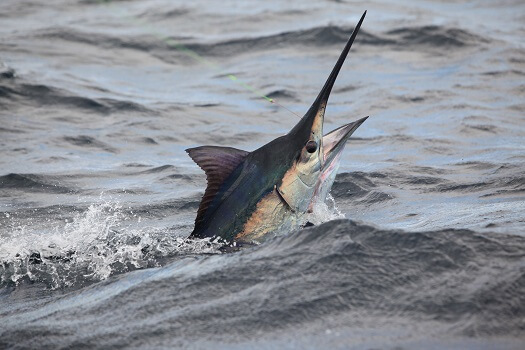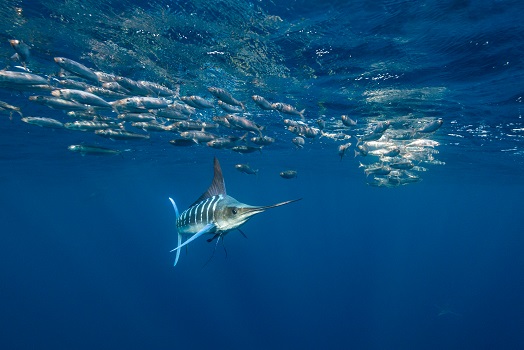
The black marlin (Istiompax indica) is a species of fish that is found in the warm waters of the Indian Ocean and the Pacific Ocean. The black marlin is one of seven different types of marlins and is also closely related to the swordfish. This fish, like all billfishes, has a distinctive elongated upper jaw. They are a strong and fast pelagic species that are highly prized by sports fishermen. This fish has a dark blue dorsal (upper) side and a light belly that is silvery-white in color. They also have faint blue vertical stripes running down their sides. Their fins are dark brown except for the first dorsal fin which is black to dark blue. The black marlin is the only species of marlin that does not have retractable fins. Black marlins feed on a range of fish and invertebrates including dolphinfish, squid, cuttlefish, octopuses, mackerel, trevallies, and swordfish. They prefer to eat small tunas when available. Scientists that have analyzed the stomach of these fish have determined that they use their long, sharp bills to slash at their prey. These fish are usually found in shallow waters close to the coast or on coral reefs. They are found at depths between zero and 915 meters, however most of the time they are found in waters between zero and 30 meters. Aside from being found in the tropical and subtropical waters of the Indian Ocean and the Pacific Ocean, they have occasionally been found in temperate waters. Black marlins congregate at spawning grounds, where they reproduce by external spawning. The females release eggs into the warm waters and the males release their sperm to fertilize them. A female can carry up to 40 million eggs. The only real threat that these fish have comes from humans who tend to hunt the fish to sell or keep as a trophy. The black marlin is a speedy swimmer that is only found in the warm waters of the Indian and the Pacific Oceans. Known for their fast pace, these fish have also been shown to migrate long distances. Let’s take a closer look at some of their biology. The Black Marlin makes the list of one of the ten fastest animals in the world! This speedy swimmer can reach amazing speeds with records showing that they can swim between 22 mph – 50 mph. Some records have even suggested they may reach speeds of up to 80 miles per hour (129 k/h) which is faster than the cheetah can run! This speed is one reason it is one of the most sought after fish for sports fishermen. Black marlin are extremely streamline and have a fusiform shape, which means they are shaped like a spindle, wider in the middle and tapered at the ends. They also have a highly rigid semilunate (half moon) tail which helps power them through the water. Black marlin are billfish and other billfish are also known for their speed, including other species of marlin as well as the sailfish, which is considered the fastest fish in the world. Scientists have tracked black marlins on their migrations and have discovered that these fish migrate huge distances, with some traveling over 8000 km! For example, two black marlins that were tagged off the coast of Australia were caught again off the coast of India and Sri Lanka. While tagging information has helped researchers to understand some of the movements that the black marlin makes, very little is known about where they spend their time. Researchers know that they aggregate and form spawning groups, but outside of this the information available is very limited. Black Marlin grow very fast and can vary in size based on whether they are male or female. For example, juvenile fish can reach around 15 kg in their first year and up tp 50 kg by the time they are three years old. Females are a lot bigger than the males. If adequate food is available its possible for a female to reach up to 450 kg (1000 lb) by the time she is 10-12 years old. In contrast, males rarely reach more than 200 kg in weight. One way that scientists can determine the age of a Black Marlin is by looking at the growth rings on a spine found on their dorsal fin. Estimating the age of an animal is important for fisheries stock assessments and conservation plans. Scientists usually age fish by counting the growth bands found on its ear bones which are known as otoliths.
Kingdom
Animalia
Phylum
Chordata
Class
Actinopterygii
Order
Istiophoriformes
Family
Istiophordae
Genus
Istiompax
Species
Istiompax indica
Niche
Carnivorous
Length
Maximum of 183.6 inches (4.6 meters)
Weight
Up to 1,653 lbs (750 kg)
Lifespan
Females: up to 12 years; Males: up to 5 years
Social Structure
Solitary
Status
Not threatened
Natural Habitat
Ocean
Average Litter Size
Females can lay up to 40 million eggs
Main food item
Fish, squid, and octopus
Main threats
Humans and human activities
The Basics

Fun Facts about the Black Marlin
Speedy Swimmers

Migrate Long Distances

Growth Rings
